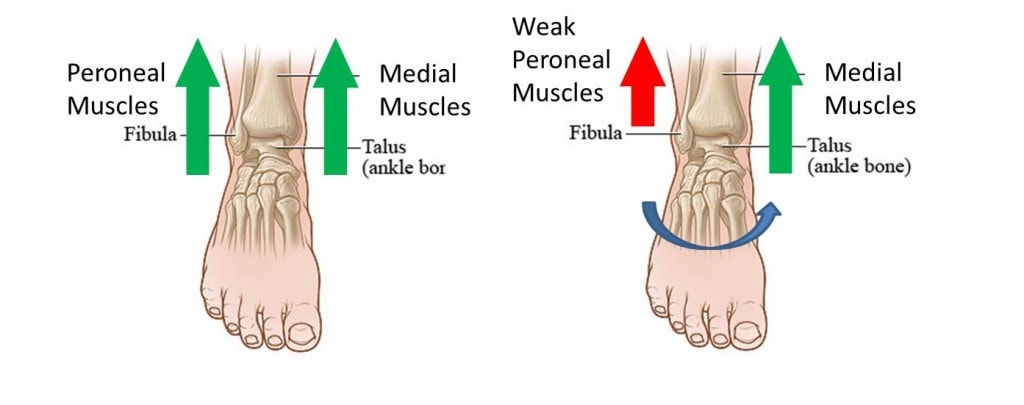Peroneus Brevis Ankle Ligament Reconstruction: Unfortunate Consequences
A Peroneus Brevis Ankle Ligament Reconstruction is a mouthful. Let me explain…
This morning I examined an unfortunate 31 year old woman who sustained a partial tear of the lateral ankle ligaments in high school. Rather than consider conservative management like ankle ligament prolotherapy (which was available at the time), she was told to have the ligaments surgically repaired. In that first surgery, the sutures failed, which lead to surgery number 2. This time they sacrificed the peroneus brevis tendon to be used as a substitute for the torn ankle ligaments. Since the peroneus brevis tendon is an important stabilizer of the outside of the ankle and pulls opposite the inside ankle muscles/tendons to keep the ankle in balance, her ankle everted (the sole of the foot pointing inside).
To understand this, see the illustration above. Note how in the left ankle picture, the peroneal muscles pull opposite the medial ankle muscles to keep the foot in balance. On the right, weakened (or removed) peroneal muscles allow the ankle to turn in, as the stronger medial muscles take over. This 2nd surgery led to her continually rolling her ankle, so they tried a 3rd surgery where they fractured several bones in the arch to try and allow the foot to lay flatter on the ground (the theory being that this would lead to less inadvertent turning of the ankle). This didn’t work, so now they want to try a 4th surgery to fuse one of the sub-talar ankle joints, in the hopes that this will reduce the inversion of the ankle. The problem with this ankle fusion surgery is that in a 31 year old active woman, this is almost certain to cause arthritis in the joints above and below the fused area.
In addition, she has significant issues with the S1 nerve in her back that have gone untreated for years, which has lead to atrophy of the calf muscle. Since the S1 nerve also innervates the peroneal muscles that help evert the foot, the already weak peroneus longus muscle (caused by the nerve problems in the back) is all that’s left to support that outside of her foot. I’ve seen this issue many times before in other patients who have had peroneal muscles/tendons removed for lateral ankle ligament reconstruction who also happen to have pinched S1 nerves in the back. Essentially, the whole foot turns inward due to the weakness in the remaining peroneal muscle, which leads to frequent “turning” of the ankle.
As I have blogged before, surgical techniques where tendons are sacrificed or moved were developed for kids with spacticity who couldn’t walk without the surgery and not for normal, healthy adults. As a result, the unintended consequences scale for these tendon reconstruction procedures is very high.

If you have questions or comments about this blog post, please email us at [email protected]
NOTE: This blog post provides general information to help the reader better understand regenerative medicine, musculoskeletal health, and related subjects. All content provided in this blog, website, or any linked materials, including text, graphics, images, patient profiles, outcomes, and information, are not intended and should not be considered or used as a substitute for medical advice, diagnosis, or treatment. Please always consult with a professional and certified healthcare provider to discuss if a treatment is right for you.

